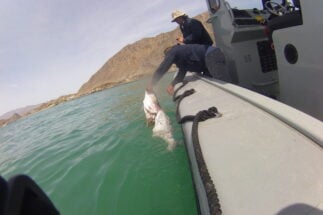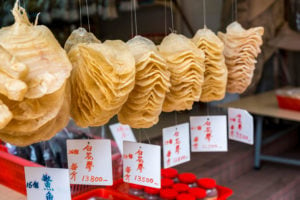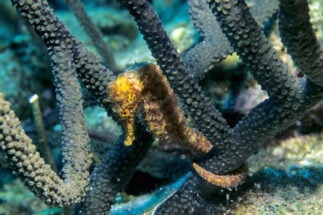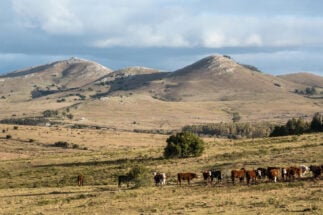Lawyer Aideé Lara received a call on the morning of 16 August 2014 from a source who told her they had just detained three Chinese citizens leaving the Mexican city of Mexicali carrying swim bladders belonging to the totoaba fish, a species trafficked from the Biosphere Reserve of the Upper Gulf of California and Colorado River Delta to China. The cost per kilo of the totoaba bladder in Asia is equal to, or more than that of cocaine.
Aideé, who was deputy director of federal crimes of the Federal Attorney for Environmental Protection (Profepa), had only been in the job of targeting totoaba traffickers one week, at an agency suffering from a lack of lawyers specialising in criminal and environmental matters. She travelled to the facilities of the then Attorney General’s Office (PGR) in Mexicali, where officers had named Li Yuan Chua and Zhang Jingzan as the culprits. But on arrival, Aideé noticed that one detainee was missing.
Did you know…?
A totoaba bladder can cost US$5,000 in Mexico and up to US$60,000 in China
One of those arrested seemed fearful. He told her voluntarily that “the Boss” had been released by the police following the payment of a large bribe. He did not say how much. He only revealed that he had been transferred to the police station along with his immediate boss, the owner of a Chinese restaurant in Tijuana.
He spoke rudimentary Spanish. Yet, when night came and he was taken to testify, he began to speak in Mandarin. The defense lawyer for the Chinese nationals brought in a representative of the Chinese community in Baja California who began translating for the authorities. Eventually, all three were freed.
Swim bladders, also known as buches, such as those carried by Chua, Jingzan, and “the Boss”, have been the subject of disputes between criminal groups of poachers fishing in the towns of the Gulf of Santa Clara and in San Felipe, Baja California. They are highly valued and consumed in gourmet soups by elites in China. However, the fishing nets used in the region not only catch the totoaba but also the vaquita, an endangered cetacean endemic to the Upper Gulf of California.
Today, fewer than 10 vaquita remain, according to the International Committee for the Recovery of the Vaquita (Cirva).

According to an interview by Mexican news agency Excelsior with Melanie Pierson, a deputy federal attorney in San Diego, and to fishermen consulted for this article, a kilo of swim bladder is priced at US$5,000 in Mexico, between $10,000 and $15,000 in the US, and once in China can fetch up to $60,000. However, fishermen say that the price has dropped to $3,000 as a result of a pandemic-induced drop in demand.
This entire supply chain works through a transnational network controlled by the Dragon Cartel. Although this is not how they refer to themselves, the sources we consulted named them such because it is made up of Chinese and Mexicans in Mexico, China and the US, who at the end of the nineties established a network in Mexicali, Baja California. Restaurant entrepreneurs handle the distribution of marine products and collaborate with intermediaries, armed poachers and authorities at different levels, according to our sources and to Profepa and Attorney General’s Office (FGR) documents obtained under Mexico’s transparency laws for this investigation by CONNECTAS, in alliance with Diálogo Chino, El Sol de México and Emeequis.
The fight against totoaba trafficking and to save the vaquita porpoise has attracted global media coverage and campaigns by international organisations and activists. Hundreds of campaigns, investigations and videos, including the documentary Sea of Shadows financed by actor Leonardo Dicaprio have created public awareness. But although the Mexican government has promised to stop the crime since the creation in 2016 of the now defunct Environmental Gendarmerie, its objectives have not been met. The battle against the Dragon Cartel is being lost.
Our investigation shows that of 42 investigations opened by Profepa and the FGR during the period 2012 to 2021, not a single arrest or other action was carried out against heads of the Dragon Cartel. In this period there were just two convictions of poachers, an effectiveness rate of 4.7%.
The files show that the Profepa and the FGR requested 23 reparations for damage caused to this species worth a combined 61 million pesos (around US$3 million). Of these, only two were resolved in favour of the authority. The rest are still pending.
10
Vaquitas are thought to remain
This investigation also found that coordinated operations between the US, Mexico and China to tackle totoaba trafficking that began in 2016 were shelved the following year. Internal reports from the Ministry of Foreign Affairs indicate that Mexico’s plan to tackle trafficking is under a “review process” by the Chinese and US governments. The document specifies that the memorandum continues to be reviewed in Beijing, which is why they are promoting a second trilateral meeting in order to exchange intelligence data.
However, reliable information is sorely lacking. An internal report by the Ministry of the Environment and Natural Resources presented in August 2019 to the Convention on International Trade in Endangered Species of Wild Fauna and Flora (Cites) in Geneva, Switzerland, says that the Mexican government barely collects information on organised crime despite identifying it as “a matter of national security in terms of sustainability”.
The fight against totoaba trafficking is also being lost because of a lack of training in criminal-environmental matters for lawyers, prosecutors, federal investigators and judges. Added to this, there is no government policy to comprehensively address the conflict and increase budgets in key surveillance areas. Corrupt officials who stall every process are the cherry on the cake of an inefficient system, claim Lara and Isarael Alvarado, a former director of Federal Crimes at Profepa, who tried to dismantle it.

As the months went by, the lawyers realised that the Dragon Cartel had quite a few allies, especially inside government. Lara also noted the interest of other Chinese businessmen in knowing about the investigations. She says she was even threatened by personnel from the navy, which mans military checkpoints.
Profepa did nothing despite the fact that national security personnel had first alerted the prosecutor in 2013 that the fact that public servants at Profepa were involved in the cartel. When Aideé decided it was time to leave, her home was raided and she later received death threats.
The history of totoaba trafficking
The relationship between the fish, the fishermen and the Chinese community began almost a century ago when The Colorado River Land Company brought Chinese citizens to construct the irrigation system in Mexicali. The Chinese established “La Chinesca”, a mostly Chinese-inhabited town in Mexicali, Baja California. When the Chinese discovered the resemblance between the totoaba and the bahaba – the eastern yellow croaker, threatened in China – whose benefits according to traditional Chinese medicine include enhancing circulation to sex organs and improving skin care, among others, they began to use the totoaba bladder.
Due to species decline, the trade in bahaba was banned in mainland China in 1989. It was added to the International Union for the Conservation of Nature’s critically endangered species list in 2006.
The Chinese who operate here do not trust the Mexicans
According to Ernesto Sosa, a historian specialising in the totoaba, the trade was started in the 1920s by Chinese brothers Juan Chein Quan and Alberto Chein Quan, owners of the La Playa store in San Felipe. They bought bladders for four cents of gold and sold them to markets in Calexico and Chinatown in San Francisco, US.
Between 1920 and 1942, according to the dataMares platform, fishing hit a historical high of 2,261 tonnes and in 1975 it reached a low of 58 tons. “There was an exponential increase in fishing effort, which could have contributed to the collapse of the fishery in 1975,” says datamares’ biological report on the totoaba, which was first listed as endangered in that year of collapse. Between 1979 and1995 catches averaged 70 tons.
The vaquita suffered a similar fate, which led to the creation in 1992 of the Technical Committee for the Preservation of the Vaquita and the Totoaba (CTPVT) . In 1993, the federal government established the Biosphere Reserve Upper Gulf of California and Delta of the Colorado River.
Social crisis in the Upper Gulf
According to fishermen, the murder of Samuel Gallardo, known as “El Samy”, a trafficker who controlled the totoaba trade along with his partners from China, Korea and Japan in 2014, led to the fragmentation of the trafficking business. Dozens of criminal groups now fight over the lucrative trade, causing bloodshed.
From 2011 to 2019, 3,476 bladders were seized by authorities, official records show. Added to this are whole fillets and totoabas weighing a combined 19 tons. Over the same period, they found 10 decomposing vaquita corpses. However, it is impossible to quantify the true loss of the vaquita, since poachers drill holes in them to sink them, dismember them or bury them in the desert, according to our sources.
The Dragon Cartel has become more sophisticated in its modus operandi every year and more intermediaries are now involved. Years ago, Chinese traffickers collected the merchandise in fishing villages. Today, Chinese restaurants serve as the delivery points.
They now have a sophisticated system, according to our guide, who explains that the fishermen deliver the bladders to a Mexican middleman in the town, and other runners moves them from house to house. A job like this is paid US$200. After passing through the hands of several Mexican intermediaries, it is delivered to the city of Mexicali or Tijuana to a trafficker of Chinese origin.
Lara explains that the routes and forms have changed: “I know that there are Chinese who are even drawing other routes; for from Nuevo León and del Bajío, for example. People with a high degree within the organisation are daring to make the transfers.”
“The Chinese who operate here do not trust the Mexicans. They operate linked to criminal organisations, but the Chinese are managerially in control […]. They carry out business management with a business vision,” explains Israel Alvarado.

According to a fisherman, the totoaba trade “came to end everything” as more and more young people are interested in getting involved in the crime, abandoning their studies and ignoring the law. He himself fights with his son who he fears will be co-opted by the illegal trade, lured by those who boast luxury cars and homes.
All this occurs in a scenario of poverty, which is evident in the poor local infrastructure, services and income. Since all fishing is prohibited to protect the vaquita, it has unleashed despair. It has been the primary source of the local economy for many villagers who are left with few economic alternatives.
As we spoke with fishermen, a man scarcely 20 metres away walked along the beach among tourists, carrying a totoaba. He placed it on the corner of the Costa Azul hotel. It was clearly still fresh, evident by the traces of blood that trickled from the wound left after the dissevering of its swim bladder.
This investigation was carried out for Diálogo Chino, Emeequis, Sol de México and CONNECTAS with the support of the International Center for Journalists (ICFJ) and its Initiative for Investigative Journalism in the Americas








